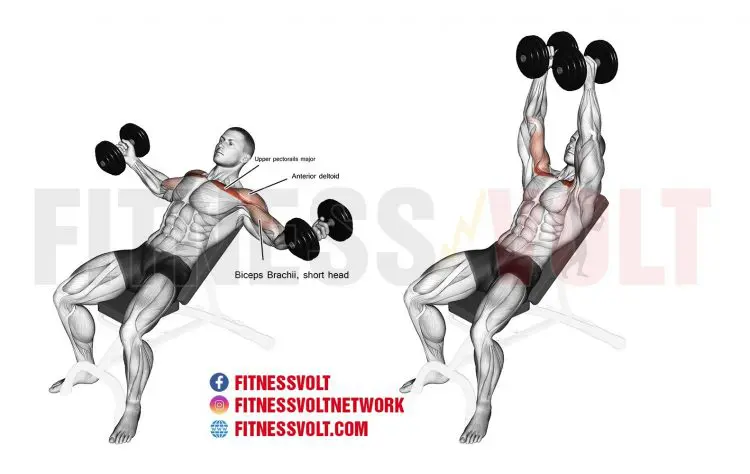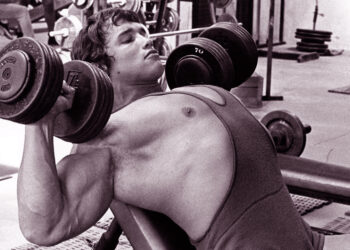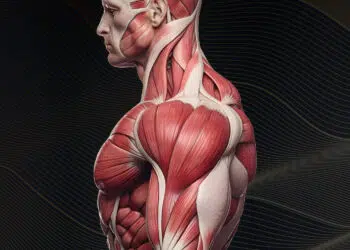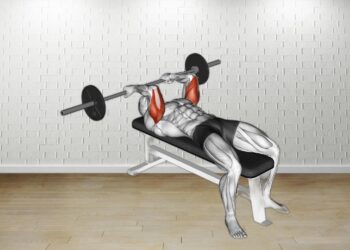Whenever I hit the gym on chest day, I always make sure to use different variations of the dumbbell incline fly for the compound sets to target my chest area holistically.
In fact, one of the studies I found on ResearchGate titled “Electromyography of Dumbbell Fly Exercise Using Different Planes and Labile Surfaces” suggested that serratus anterior and the anterior deltoid muscle activation is higher in the incline versus the horizontal position. (1)
Since you will likely perform some bench press variation before flyes, your chest is probably already fatigued.
That’s why you should include incline flyes right afterward. This lets you target the remaining muscles, such as the serratus anterior and the anterior deltoid, better and develop a big and strong chest.
As a Faculty of Sport and Physical Education student, I have prepared this easy-to-follow step-by-step guide below so you can perform dumbbell incline flyes with perfect form and technique.
Afterward, you will also learn about the benefits of incline dumbbell flyes, the muscles worked during this exercise, and the most important variations and alternatives to incorporate into your workout sessions.
Level Up Your Fitness: Join our 💪 strong community in Fitness Volt Newsletter. Get daily inspiration, expert-backed workouts, nutrition tips, the latest in strength sports, and the support you need to reach your goals. Subscribe for free!
Dumbbell Incline Fly: Step-By-Step Guide
Below, you can find a step-by-step guide on how to perform the dumbbell incline fly without injuries.
Step One — Assume the Starting Lying Position With Dumbbells
Pick two dumbbells of appropriate weight. Set the incline at about 30 degrees to hit your upper chest perfectly. Lie on the incline bench on your back and extend the weight right above the level of your chest. Place your feet on the ground and make sure they provide enough stability during the entire exercise.
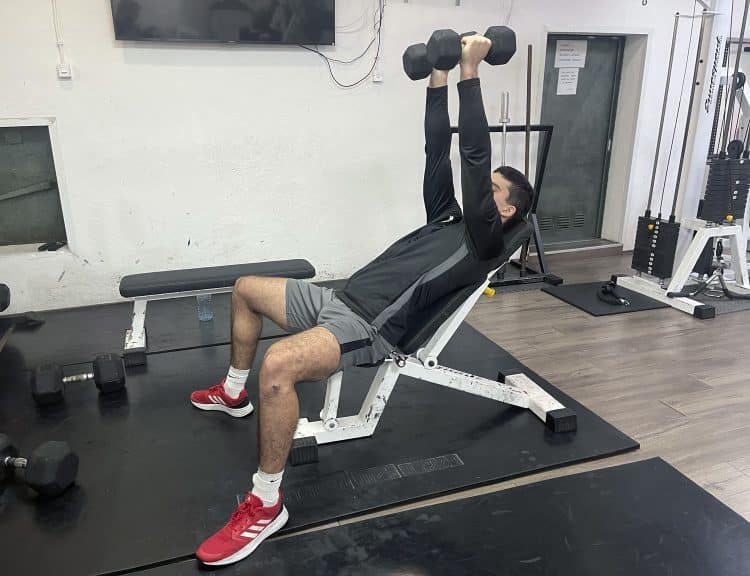
Pro Tip: If you lack stability during the exercise, like me, widen your stance more. While this won’t significantly change your center of gravity, it will definitely increase your area of support. Area of support is the second most significant factor for achieving a balanced position.
Step Two — Abduct/Lower the Dumbbells (Eccentrics)
Start the exercise by lowering the dumbbells to the floor by moving them out and away from each other. Make sure to keep your elbows slightly flexed but fixed during the entire movement.
You don’t want to leave your elbows fully extended or flexed at 90 degrees. The first will result in a bad injury, and the second will transform the exercise into an incline dumbbell press. Stop when your elbows just pass the line of your body (frontal plane).
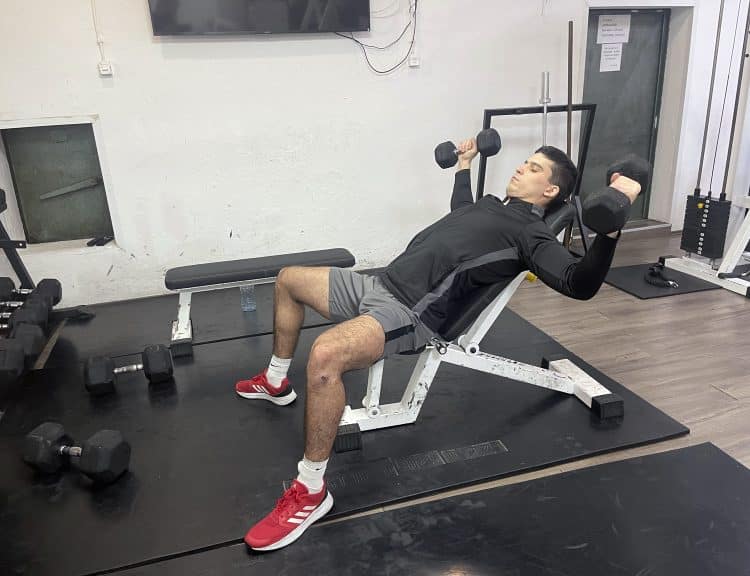
Pro Tip: During the eccentric (lowering) phase of the dumbbell incline flyes, I suggest you focus on a controlled, slow descent. Based on my experience, this not only enhances muscle tension but also minimizes the risk of shoulder injuries.
Step Three — Adduct/Bring the Dumbbells Together (Concentrics)
Adduct your shoulders (move your arms towards the center of your body) to return the dumbbells to the starting position. To build strength and power, bring them as fast as you can to the starting position. For hypertrophy, change the tempo of the concentric phase to 2 seconds for better muscle growth results.
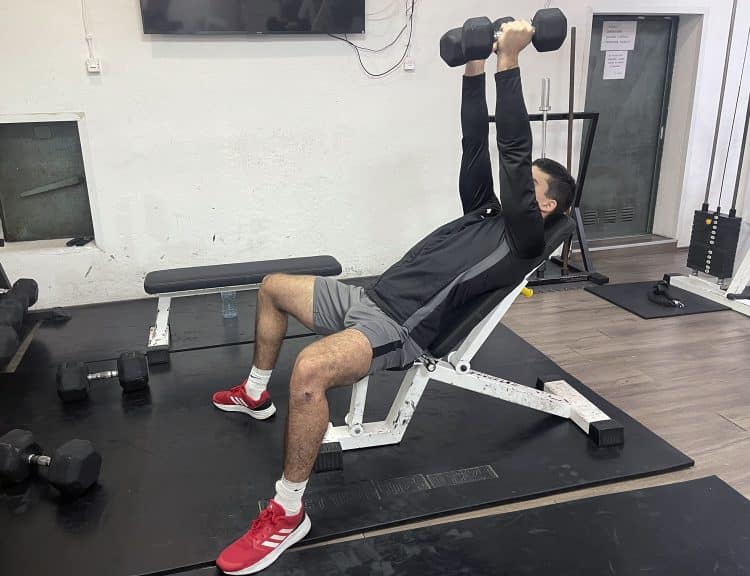
Pro Tip: Visualize “hugging a large tree” as you lift the weights. I use this mental image to maintain the correct form by encouraging a slight bend in my elbows, and you can do the same. It also ensures that your chest muscles, rather than your arms, are doing the work.
Watch: How to do the incline dumbbell fly
Muscles Targeted by Dumbbell Incline Flyes
After carefully analyzing all the working muscles, I divided them into primary and secondary muscle groups.
According to my biomechanical analysis, the primary muscle working is the pectoralis major.
To be more precise, the clavicular/upper head of this muscle is the most engaged part during the dumbbell incline fly exercise.
Also, here are the secondary muscles working as well:
- Deltoids
- Triceps
- Serratus Anterior
- Biceps
What Are the Benefits of Dumbbell Incline Flyes?
The benefits of dumbbell incline flyes include targeted upper chest muscle growth, strengthening of the anterior deltoids, improved shoulder joint flexibility, enhanced activation of stabilizer muscles, and better posture through upper back muscle engagement.
Let’s tackle all these benefits briefly below.
Targeted Upper Chest Muscle Growth
Dumbbell incline flyes are an excellent addition to your chest day to develop your chest muscles even further.
I don’t recommend going too heavy on flyes, but implementing them as the supersets during pull days or one of three exercises during compound sets has proven to be extremely beneficial.
Strengthening of the Anterior Deltoids (Front Shoulders)
If you perform just about any variation of dumbbell flyes incorrectly, you will likely injure your anterior deltoid muscles. (2)
I know because it happened to me recently, and it wasn’t pleasant at all.
That’s because the dumbbell fly requires a substantial stretch in your chest and deltoid muscles, and most people nowadays simply lack that flexibility or go too hard too early.
However, if you pick the proper weight, warm up adequately, and perform the exercise with perfect dumbbell trajectory, you will likely strengthen your anterior deltoid muscles. You will make them more resilient to external stressors, thus lowering the chance of potential injuries and improving your strength.
Improved Shoulder Joint Flexibility
As noted before, dumbbell flyes require substantial shoulder joint flexibility so you don’t injure yourself. This is why it is important you perform the range of motion only you are comfortable with, and maybe a little over that, but that’s it.
If you perform incline dumbbell flyes correctly with good form and technique, passive stretching from the weight and active contraction from your muscles will build both shoulder flexibility and mobility.
Level Up Your Fitness: Join our 💪 strong community in Fitness Volt Newsletter. Get daily inspiration, expert-backed workouts, nutrition tips, the latest in strength sports, and the support you need to reach your goals. Subscribe for free!
Enhanced Activation of Stabilizer Muscles
Dumbbells are excellent for challenging your stabilizer muscles. I recommend using free weights in general to build more functional strength.
They force you to activate the muscles of your core and posterior chain to stabilize your body during movement. As a consequence, you will develop better balance, which will lower the chance of potential injuries.
Better Posture Through Upper Back Muscle Engagement
What I like about this exercise so much is it will allow the movement of your shoulder blades. In today’s day and age, we suffer the modern lifestyle syndrome, which often results in a kyphotic or rounded spine and forward-positioned neck (cervical lordosis).
Dumbbell incline flyes will allow retraction and protraction (moving towards and away from your spine) of your shoulder blades (scapula). This will activate the muscles around that area, which are responsible for keeping your spine in a neutral physiological position.
Dumbbell Incline Fly Variations and Alternatives
Below, you can find the best dumbbell incline fly variations and alternatives.
Cable Incline Fly
What I personally dig about cable incline flyes is they will provide the same tension throughout the whole range of motion. However, this is only assuming you don’t perform the movement so explosively that it lifts the weight increments and makes the cable “lighter,” so to speak.
Steps:
- Load the cable machine with the appropriate weight.
- Set the incline bench in the middle of the cable machine.
- Set attachments on both sides, take each one in a separate hand, and lie on the incline bench.
- Extend both cables above your chest, just as you would with the dumbbell variation.
- Slowly move your arms from each other and lower the cable attachments towards the floor.
- When your elbows just break the line of your body, hold that position for one second.
- Reverse the motion by abducting your shoulders and bringing your arms towards each other.
- Repeat for the desired amount of reps.
Pro Tip: Hold the bottom position for up to 3 seconds of isometric contraction to bulletproof your shoulders and lower the chance of injury significantly.
Incline Dumbbell Chest Press
The incline dumbbell chest press is one of my favorite exercises since it will develop the upper chest area, which is the most visible part of your pectoralis major.
Most bodybuilders choose the incline bench press variation since it develops the chest better, looking from the aesthetics side of things.
Steps:
- Set the incline to around 30 degrees.
- Pick two dumbbells of appropriate weight and lie on your back on the bench.
- Extend the dumbbells above your chest with your elbows locked.
- Lower the dumbbells towards the floor to initiate the eccentric part of the lift.
- When the dumbbells reach the level of your chest, hold that position for one second.
- Reverse the motion by extending your elbows to return the dumbbells to the starting position.
- Repeat for the desired amount of reps.
Pro Tip: Slightly rotate the dumbbells inward to change the angle of your shoulders and perform the exercise more safely.
Flat Bench Dumbbell Fly
Flat bench dumbbell fly targets your pectoral, anterior deltoid, and tricep muscles. There isn’t much more to say about the exercise except that it’s an excellent addition to the end of your chest workout.
Steps:
- Pick two dumbbells of appropriate weight and lie on the flat bench.
- Make sure your feet have a firm grip on the ground for better stability.
- Extend the dumbbells above your chest with your elbows locked.
- Slowly move away and lower the dumbbells from each other to bring them to the bottom position.
- When your elbows break the line of your body, stop for one second.
- Reverse the motion by returning the dumbbells to the starting position.
- Repeat for the desired amount of reps.
Pro Tip: As you bring the dumbbells together at the top of the movement, slightly rotate your wrists so that your pinkies are higher than your thumbs. This subtle wrist rotation at the peak of the contraction can intensify the squeeze in the chest muscles.
Decline Dumbbell Fly
Decline dumbbell fly is excellent at targeting your lower pectoral fibers and building your chest more holistically.
Steps:
- Pick two dumbbells of appropriate weight.
- Set the decline at about 30 degrees to hit your lower chest perfectly.
- Lie on the decline bench on your back and extend the weight right above the level of your chest.
- Place your feet behind the leg extension and make sure they provide enough stability during the entire exercise.
- Extend the dumbbells above your chest with your elbows locked.
- Slowly move away (abduct) and lower the dumbbells from each other to bring them to the bottom position.
- When your elbows break the line of your body, stop for one second.
- Reverse the motion by returning the dumbbells to the starting position and repeat for the desired amount of reps.
Pro Tip: As you lower the dumbbells, imagine tracing a wide arc with your hands, moving them in a broad, sweeping motion. This technique not only enhances the stretch in the lower chest muscles but also ensures a more comprehensive engagement of the entire pectoral region.
Resistance Band Incline Fly
What I like about the resistance band incline fly is it will provide progressive tension to your chest muscles. This is effective because the closer you are to your end range of motion, the easier it gets.
But with resistance bands, the closer you move to the end range of motion, the harder it gets. Essentially, you get to make the part that was supposed to be easy considerably harder.
Steps:
- Set the incline to around 30 degrees.
- Tie two resistance bands to squat pols or some other immovable object.
- Lie on the bench and extend your hands right above your chest.
- Slowly move down and away your arms from each other to enter the bottom position.
- Hold the bottom position for one second.
- Reverse the motion by bringing your arms back together.
- Repeat for the desired amount of reps.
Pro Tip: First, perform regular dumbbell incline flyes, and then immediately afterward, perform the banded version. However, you want to perform the banded version of the exercise as quickly as possible. This is contrast training, and many athletes use it to build a base level of explosive strength and strength endurance.
FAQ’s
Are incline dumbbell flyes effective?
Yes, incline dumbbell flyes are particularly effective for developing strong and wide chest muscles. More precisely, this exercise is excellent for developing the upper chest muscle fibers.
Is bench press better than DB fly?
The bench press is better for developing strength and power. Dumbbell flyes are good to add as a supplementary exercise to your regular bench press workouts. In my opinion, they should serve as finishers or second or third exercises in your chest compound sets.
What is the ideal range for dumbbell incline flyes?
The ideal rep range for the dumbbell incline flyes is anywhere between 6 and 12. This means you should pick the weight between 60-80% of your 1RM (repetition maximum). Going anywhere heavier than that can cause serious anterior deltoid injuries, and we definitely want to avoid that.
Wrapping Up
Incline dumbbell flyes are an excellent addition to your bench press workout sessions. You can effectively utilize them to increase your muscle hypertrophy effects further while also widening your chest and incorporating certain diversity and versatility in your push workouts.
I recommend performing anywhere between 6 and 12 reps of this exercise with 60-80% of your 1RM (repetition maximum) to avoid injuring your anterior deltoids. In the comments below, please share your thoughts on this exercise and how you implement it in your own workout routine.
References:
- Reiser F, Lira J, Bonfim B, et al. Electromyography of Dumbbell Fly Exercise Using Different Planes and Labile Surfaces. J Exerc Physiol Online. 2017;20:31. Published 2017.
- Bonilla DA, Cardozo LA, Vélez-Gutiérrez JM, et al. Exercise Selection and Common Injuries in Fitness Centers: A Systematic Integrative Review and Practical Recommendations. Int J Environ Res Public Health. 2022;19(19):12710. Published 2022 Oct 5. doi:10.3390/ijerph191912710
Relevant Articles:
Interested in measuring your progress? Check out our strength standards for Bench Press, Incline Dumbbell Fly, Cable Fly, and more.

